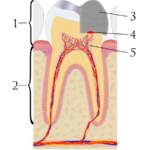
Preserving pulp vitality is important for long-term tooth survival. Deep carious lesions can compromise the pulp and these have been traditionally managed with complete (non-selective) caries removal. Although, recent evidence supports more conservative, partial (selective) caries removal a non-selective approach is common. This may lead to carious exposure which may be managed by direct pulp capping (DPC), partial and complete pulpotomy or more invasive pulpectomy and root canal treatment. While DPC has been the subject of many studies over the year recent studies have involved more biocompatible materials and have been associated with higher success rates.
The aim of this review was to determine the outcome of direct pulp capping (DPC) in mature permanent teeth with a cariously exposed pulp and a clinical diagnosis of reversible pulpitis and assess whether the capping material influences the outcome.
Methods
Searches were conducted in the Medline, Embase, Cochrane Central Register of Controlled trials (CENTRAL), the International Clinical Trials Registry Platform, Clinicaltrials.gov, the Web of Science and the SIGLE databases. Randomised control clinical trials (RCTs), retrospective and prospective studies involving DPC in mature permanent teeth with at least one year follow up period and published in English were considered. The primary outcome was success (absence of clinical or radiographic symptoms and positive response to pulp testing) after one year. Risk of bias was assessed by 3 reviewers using the modified Downs and Black quality assessment checklist for non-randomised studies and the Cochrane tool for RCTs. Two reviewers independently extracted data success rate calculated and random-effect meta-analysis conducted.
Results
- 14 studies (5 RCTs, 5 non-randomized comparative studies, 4 single-arm prospective studies) were included.
- 5 of the 9 non-randomised studies were considered to be of fair quality the remainder were of poor quality. The 5 RCTs were at high risk of bias.
- The pooled success rates for DPC with calcium hydroxide, MTA (mineral trioxide aggregate) and Biodentine are shown in the table below.
| Success Rates | Calcium hydroxide | MTA | Biodentine |
| 6 months | 74% | 91% | 96% |
| 12-months | 65% | 86% | 86% |
| 2- to 3-years | 59% | 84% | 86% |
| 4- to 5-years | 56% | 81% | N/A |
- Meta-analysis showed no significant difference in the success rate of calcium hydroxide and MTA at 6 months. However, MTA performed better than calcium hydroxide at 12 months, Odds ratio (OR) = 2.66 (95%CI; 1.46– 4.84) and 2–3 years, OR = 2.21 (95%CI; 1.42–3.44).
- No significant differences between MTA and Biodentine at any time point was found on meta-analysis.
Conclusions
The authors concluded: –
The evidence in this review suggests that direct pulp capping is generally a clinically effective procedure for treating teeth with deep caries and pathologically exposed pulps if the pulpal diagnosis is reversible pulpitis. There is no evidence to support a difference in short-term success (up to 6 months) between calcium hydroxide and calcium silicate cements, but MTA and Biodentine were better than calcium hydroxide in the long term. Critically, this evidence comes from studies with evidence of high risk of bias and low methodological quality. Future well designed and adequately powered randomized trials are required to determine whether these findings are correct in order to resolve ongoing uncertainties.
Comments
This protocol for this review was registered on PROSPERO and was reported following the PRISMA guidelines. A good range of databases was searched although the inclusion of only English language papers may have excluded some relevant studies. As the authors highlight in the discussion most of the included studies were of low methodological quality and this needs to be taken into account when considering the findings. While the findings suggest that, ‘the success of calcium hydroxide reduces with long-term follow-up, whilst that of MTA and Biodentine remained reasonably stable’ the number of studies is small and few studies involved Biodentine so again caution is required in interpreting the findings. The discussion highlights some areas of debate including the impact of patient age and the depth and extent of the carious lesion. SO as the authors suggest further high quality well conducted and reported studies of appropriate size are required to confirm and clarify these findings.
Links
Primary Paper
Cushley S, Duncan HF, Lappin MJ, Chua P, Elamin AD, Clarke M, El-Karim IA. Efficacy of direct pulp capping for management of cariously exposed pulps in permanent teeth: a systematic review and meta-analysis. Int Endod J. 2020 Nov 22. doi: 10.1111/iej.13449. Epub ahead of print. PMID: 33222178.
Other references
Dental Elf – 22nd Jul 2019
Dental Elf – 5th Sep 2018
Dental Elf – 21st Jul 2017
Pulp capping carious exposures in adults: calcium hydroxide or MTA?
Photo credits
Ian Furst, Goran tek-en / CC BY-SA
